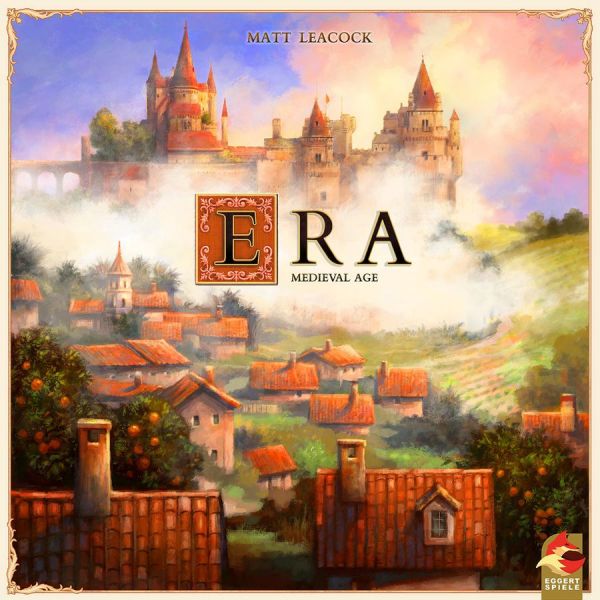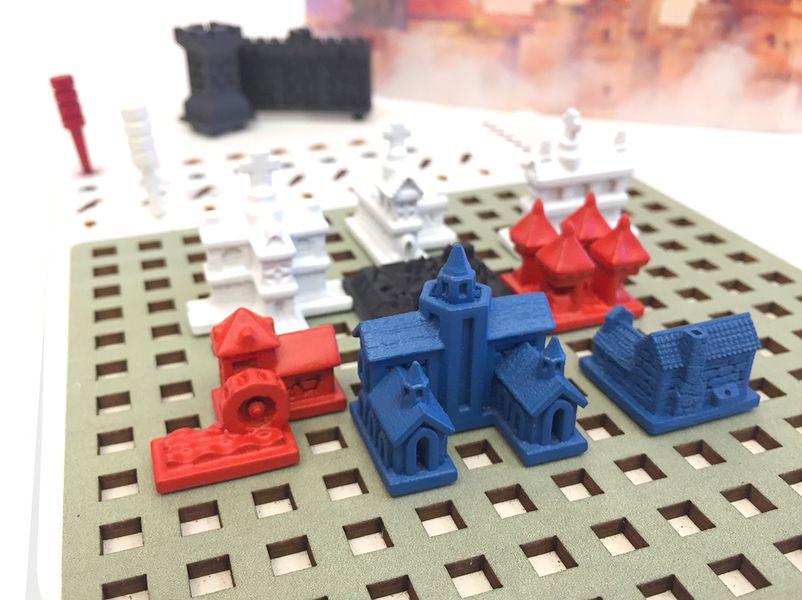Build the Best Fiefdom in Era: Medieval Age

Gather resources and spend them wisely to build your city (and its walls) in a new reworking of Roll Through the Ages by Matt Leacock.
Gameplay
Era: Medieval Age is a 1-4 player game that finds players rolling dice for resources to build the city with the most points. Players begin with their own city peg board, three walls and longhouses, a tower, and a farm (and depending on player counts, perhaps some scorched earth where no building can occur). The tower is placed in the middle of the board, with the other buildings placed at each player’s discretion. The board will also help players keep track of trade goods, stone, wood, and food that is accumulated by rolling the dice. Likewise, tracks for culture and disasters are also represented on the right margin as players hope to increase their culture for points at the end, while limiting the amount of disaster they accumulate throughout the course of the game.
Players will each roll their starting dice (one gray and three yellow) behind their personal screens. Die faces will include several resources, culture, shields, swords, hammers, and skulls. If a player rolls a skull, they must place that die aside before re-rolling any dice. Players have up to three rolls before unveiling what they have rolled to the rest of the group. Then, players will move the pegs to their appropriate spot on the board to note how much of a resource they have gained in their inventories. Resolving skulls is dependent on how many skulls a player has rolled. These will cause an adverse effect to oneself or the other players. Adverse effects for oneself may include gaining spots on the disaster track (which are negative points at the end of the game), loss of a building, or adding scorched earth to a player board. Likewise, a set number of skulls may provide players the chance to harm another player by giving them scorched earth or costing them a building.
Hammers are resolved with players spending resources on a large assortment of buildings at their disposal. Some buildings will provide additional dice (for example, dice of a specific color allow players to gain culture, others provide access to trade goods), special benefits (a hospital will prevent any buildings touching it from being lost due to disasters), or beneficial to end game scoring. Player screens provide a key for these benefits. Swords and shields on the gray dice are resolved with the player with the most swords being able to take one resource from every other player; the player with the second most swords takes from those with less, and so on. Shields allow players to reduce the number of swords they may suffer in these exchanges. In a solo game, players will roll dice for a dummy player and if their the dummy player has more swords, the solo player will lose a resource and a higher sword count will grant them an additional resource (with shields working the same for the solo player).
The end game is triggered differently between the solo and multiplayer variants. In a multiplayer game, once five building types are exhausted, then final scoring occurs. In a solo game, play lasts for eight rounds before final scoring occurs. Points from buildings, resources, and culture are scored. Bonus scoring may occur as well, including any buildings that are completely walled in being worth double or bonus points being awarded to remaining resources. Players will lose the number of points on the disaster track, with the highest point earned being declared the winner.

Review
The first thing you will notice about Era: Medieval Age is the price tag. The manufacturer’s suggested retail price (MSRP) is $70. The second thing will be the very yellow peg board that is central to building and tracking. It is very hard to read, and though the color choice allows the peg board to stand out, any player with a visual impairment will have trouble discerning what is what when looking at resources until they are familiar with the game.
Most people will look at the game and wonder why it is not a roll and write, but rather a roll and build. Once play begins it will become evident that the tactile nature of the game allows for advanced planning, easier visualization when strategizing, and a general feeling of accomplishment. It's also clear that the yellow peg board was a good choice in allowing the buildings to pop when placed (except for the similarly-colored yellow farms and longhouses). When players begin to feel the great quality components and notice the great packaging, Era: Medieval Age becomes a go-to game because it’s easy to get out and play immediately, and the components plus this ease of play makes it well worth its purchase price.
Players who feel a bit turned off by the take-that elements of the game should not be discouraged (unless their gaming group is full of cutthroats). Players are far more tuned to building their own fiefdoms than cruelly disturbing those of other players, so skulls are often more of a casual punishment unwittingly doled out to oneself rather than other players. Likewise, the swords and shields element provide a fun give and take that gets players to interact in a game where they otherwise may not — and perhaps to flourish when they may find themselves struck by bad rolls.
Aside from the yellow boards (and many people are finding creative ways to make the peg boards stand out and look wonderful), there is very little to nitpick with Era: Medieval Age. It is the first in a trilogy of games expected by Matt Leacock as he and Plan B Games rethink and re-tool Roll Through the Ages, so expect different mechanics, meatier gameplay, and more strategy options in next year’s edition. And please, easier-to-read peg boards.
Pros: Fantastic upgrade to roll and write games, fun gameplay, high quality components, easy to pick up and play
Cons: Unreadable player boards, high price tag may be a turnoff to budget-minded gaming families




